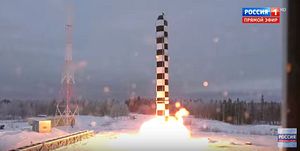Russia will complete testing of a new silo-based intercontinental-range ballistic missile (ICBM), the super-heavy thermonuclear-armed RS-28 Sarmat (NATO designation: SS-X-30 Satan 2), in late 2020, according to a senior Russian government official. “Firing tests are already underway,” the head of Russia’s State Space Corporation Roscosmosm, Dmitry Rogozin, was quoted as saying by TASS news agency on July 6. “The bulk of firing tests will be completed by the end of the year. We expect the closing stage of tests at the end of next year.”
In April, Russian President Vladimir Putin claimed that “the final tests of the missile Sarmat are proceeding successfully.” To date, Russia has not made public any flight tests of the Sarmat ICBM, although Russian government sources indicated in October 2018 that flight trials of the new missile would commence in the spring of 2019 at the at the Plesetsk space center, located in Arkhangelsk Oblast approximately 800 kilometers north of Moscow. The first round of flight trials specifically seek to test the Sarmat’s second- and third-stage engines.
Russia conducted the third and last ejection (also known as pop-up) test of the RS-28 Sarmat in May 2018. Two other ejection tests took place in March 2018 and December 2017 and involved the ignition of the ICBM’s first-stage and booster engine. The missile’s first stage engine is likely the PDU-99 — a modified version of the RD-274 liquid rocket engine used on the RS-36M2 Voyevoda ICBM (NATO designation: SS-18 Satan).
Serial production of the Sarmat is expected to begin in 2021 pending the successful completion of the testing phase. That same year, the first unit of the Russian Strategic Rocket Forces is slated to receive the new ICBM. A regiment of the 62nd Missile Division, deployed in Uzhur, part of the 33rd Guards Missile Army, headquartered in Omsk in southwestern Siberia, will reportedly receive two silo-based RS-28 ICBMs in 2021 with four more ICBMs delivered the following year.
“In total, seven regiments – with six missiles in a regiment plus one ten-missile regiment for a total count of 46 RS-28s – will be deployed and split up between two missile divisions based in Dombarovskiy and Uzhur,” I explained in October 2018. “The RS-28 is slated to gradually replace the Strategic Missile Forces’ arsenal of Soviet-era RS-36M2 Voyevoda (NATO designation: SS-18 Satan) ICBMs by the middle of the 2020s.”
The RS-28 Sarmat was designed to replace the RS-36M2 — the current mainstay of Russia’s silo-based ICBM force — by the mid-2020s. However, it is unclear whether this schedule will be kept. “The RS-28 program has been plagued by delays including multiple postponements of ejections tests,” I explained previously. “It remains doubtful that the ICBM will be operational by 2021. Originally, it was assumed that the first missile would be delivered to the Strategic Missile Forces in 2015.”
































